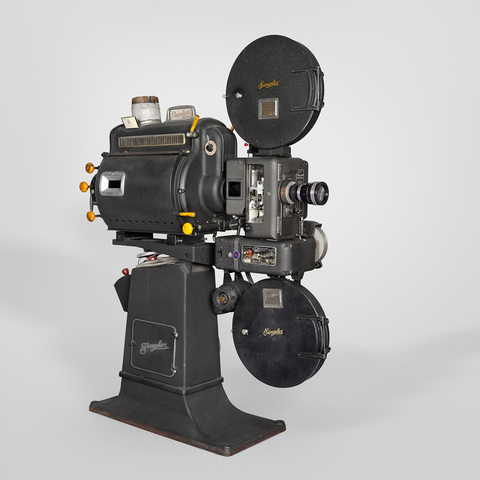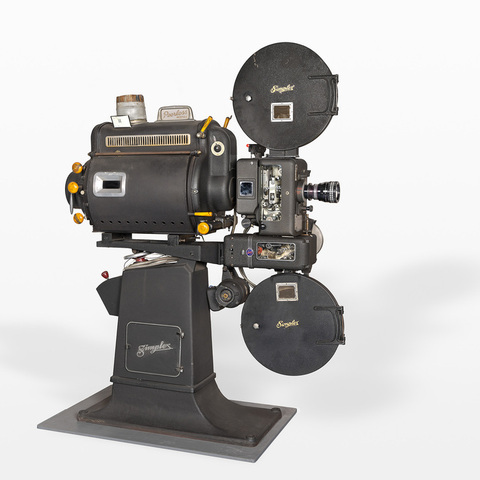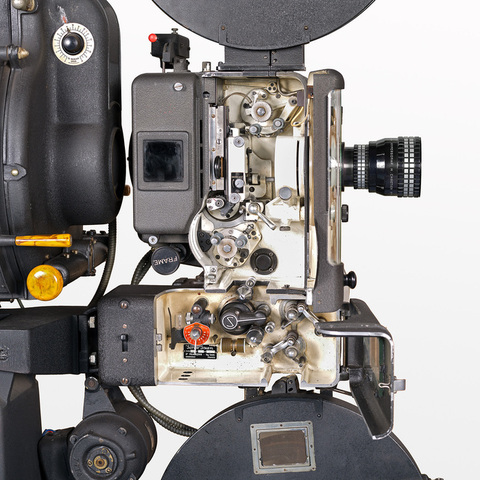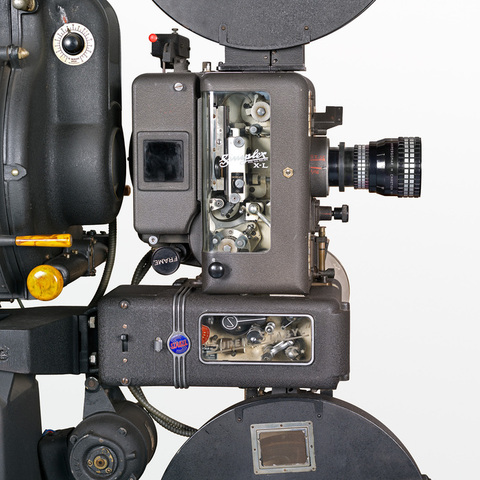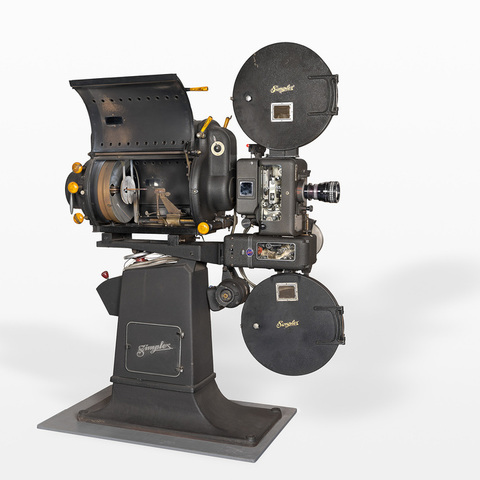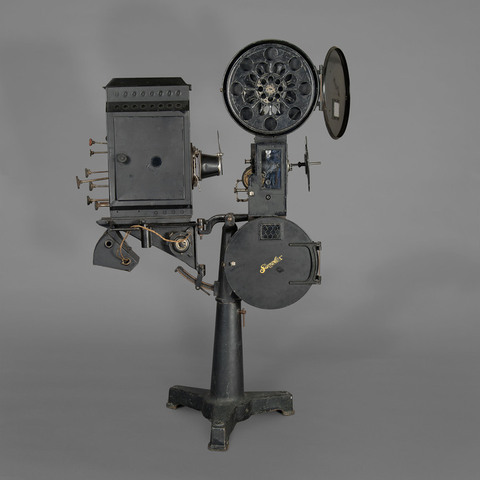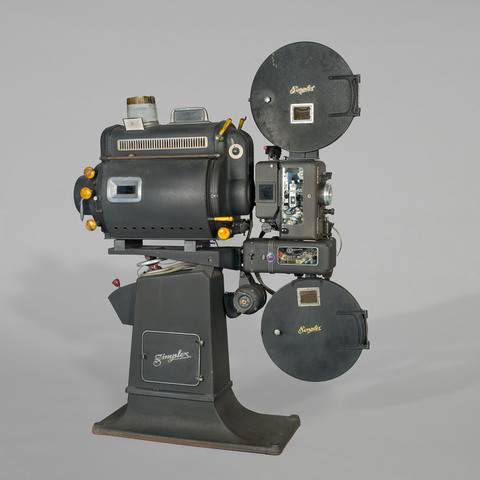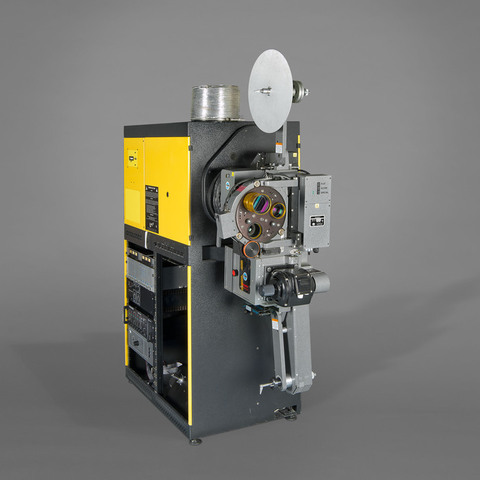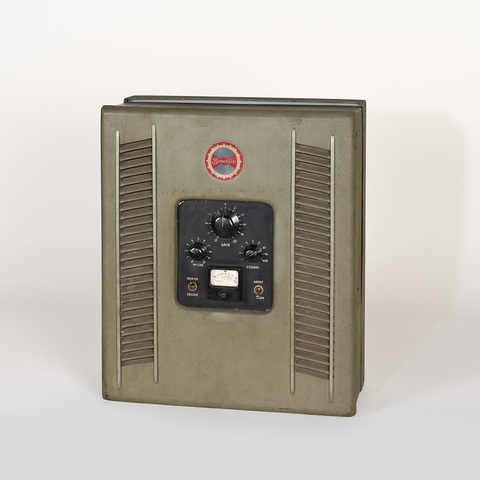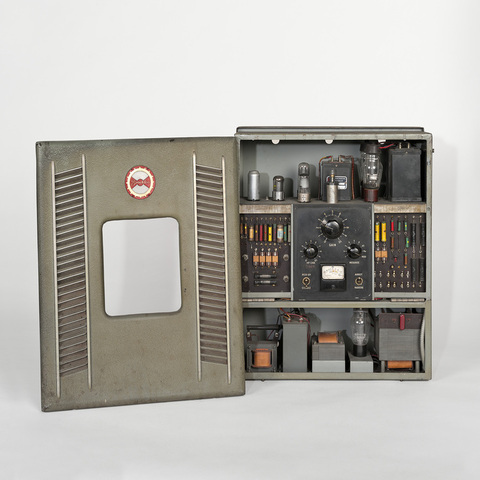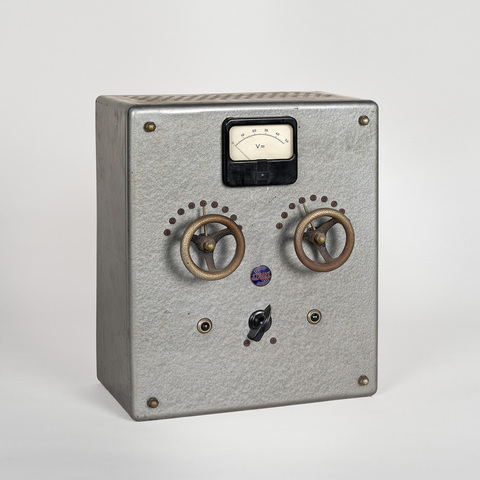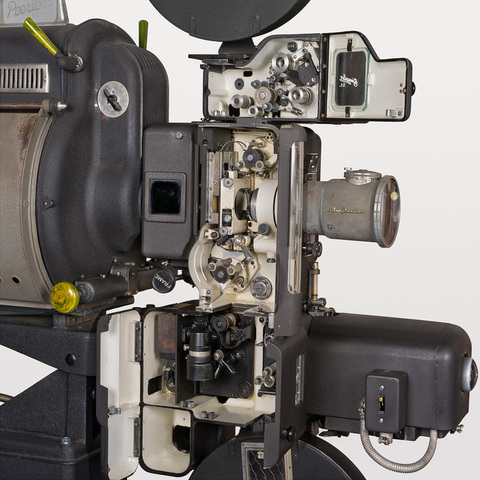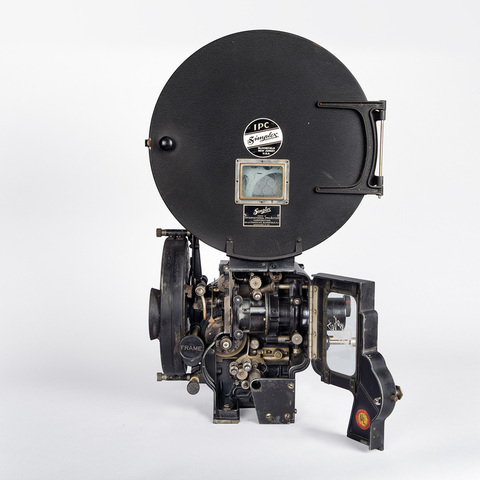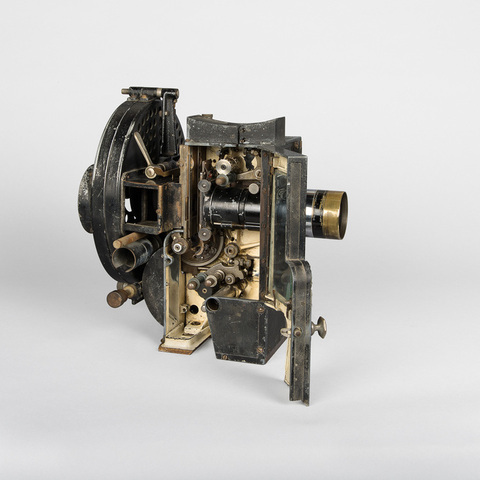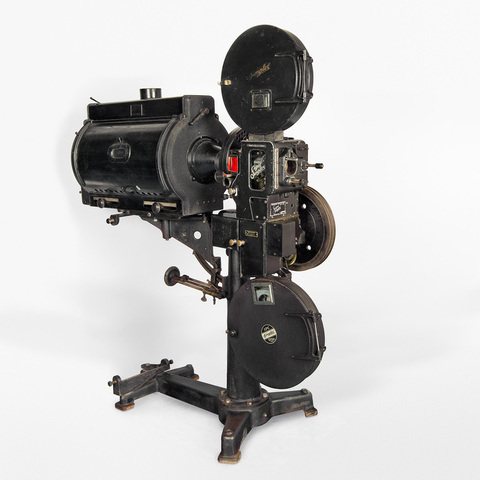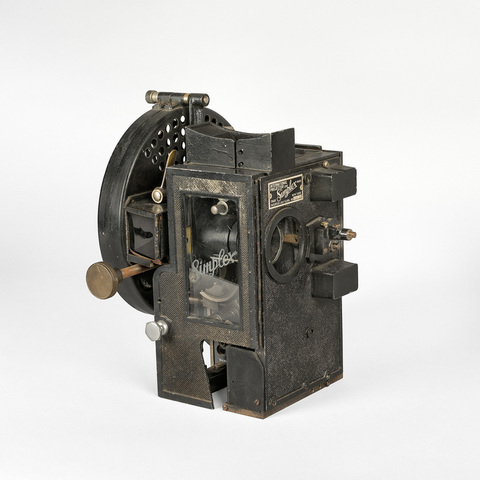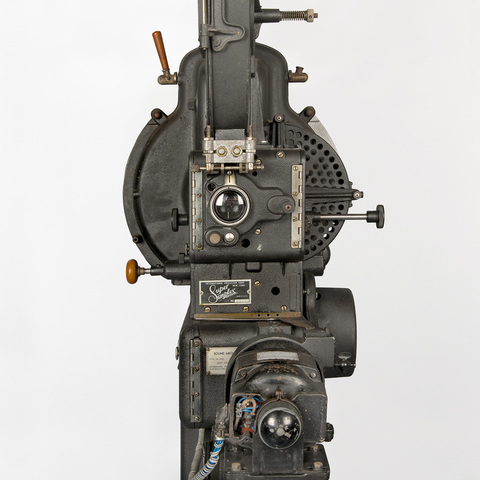Projecteur de film 35 mm sonore
Fiche détaillée
Type de l'appareil
entraînement du film 35 mm sonore par croix de Malte à bain d'huile ; quatre débiteurs dentés ; carters débiteur et récepteur ; obturateur conique à deux pales ; éclairage interne pour guider la mise en place du film ; lanterne Peerless Magnarc type E high intensity à arcs ; base en fonte avec table réglable ; lecteur son Super Stabyl type S.J. ; Simplex electric changeover model S A 5 ; moteurs électriques incorporés
Auteurs
Informations non disponibles
Fabricants
International Projector Corporation
New York, 88-96 Gold Street, New York
J. E. Mc Auley Manufacturing Company
Chicago, Illinois
F. François établissements
Grenoble, 4 rue du Rhin
Utilisateurs
Informations non disponibles
Distributeurs
National Theatre Supply Division of National Simplex
Sujet du modèle
Informations non disponibles
Objectif
[Ikon Kinostar f = 11 cm]
Taille de l'objet
Ouvert :
Informations non disponibles
Fermé :
Longueur : 150 cm
Largeur : 60 cm
Hauteur : 193 cm
Diamètre :
Informations non disponibles
Taille de la boîte de transport
Informations non disponibles
Remarques
Marques : "International Projector Corp., Bloomfield, N.J., made in USA, Simplex X-L 35 mm projector PR - 1004 Serial n° XL-7388" ; "Super Stabyl type S.J. Série C n° 313, Ets François Ing. construc. Grenoble" ; "Simplex electric changeover model S A 5 serial 5365, Essanay Electric Co., 1438 N. Clark St. Chicago, Ill.". Sur la lanterne : "The Peerless Magnarc type E High Intensity lamp serial n° 4275, volts 31-40, amp. 32-62, Mf. J.E. Mc Auley Mfg Co., Chicago, Ill."
Projecteur provenant de la Cité Universitaire à Paris (cabine démontée en 2000).
Le premier Simplex a été fabriqué de 1907 à 1924 (CNC AP-97-818). Un deuxième modèle plus évolué suit, de 1925 à 1936. Un troisième modèle "Super Simplex" (obturateur arrière sous carter) est fabriqué de 1937 à 1946 (CNC AP-18-1331). Puis vient le Simplex X-L (AP-12-2760 et 2761).
Le lecteur son est un Super Stabyl type S.J. série C fabriqué par les établissements François à Grenoble.
"La grande nouveauté présentée par les Ets Brockliss-Simplex est un projecteur sonore 35 mm, de conception et de réalisation extrêmement soignées : le Simplex XL. Cet appareil, qui est importé des Etats-Unis (comme la majorité des divers appareils de la firme), offre aux usagers une garantie absolue de cinq ans, pour une utilisation de 10 à 16 heures par jour. [...] Les innovations sont centralisées dans la partie mécanique et optique du Simplex XL, partie incorporée sous une porte de plexiglass : un tambour de 24 dents entraîne le film avec une vitesse de rotation moindre que sur un tambour doté d'un nombre de dents plus petit ; il en résulte une usure moindre également ; l'ensemble du bloc, des presseurs et du pignon, est démontable. La contre-porte mobile, comme sur tous les modèles Simplex, possède des patins maintenant le film sur une longueur de 12 images, avec possibilité de réglage de ces patins en cours de marche. La fenêtre est en acier spécial traité, pratiquement inusable ; la gorge de défilement est incurvée pour éviter le battement du film refroidi par la soufflerie très puissante. Le cadrage se fait sur la fenêtre spéciale. L'obturateur possède la particularité d'être tronconique à double pales à 45° et tourne à 440 t/m ; il attaque le faisceau lumineux au ras de la pellicule, réduisant au minimum le temps d'obturation ; cet emplacement fait gagner 35 à 40 % de luminosité sur les modèles précédents. De plus, l'obturateur, doté de palettes, forme turbine d'aération et l'évacuation des calories s'effectue par un couloir spécial d'échappement. [...] Le graissage est automatique, par pompe centrifuge" (Le Film français, n° 319-320, 1949).
"The Simplex X-L Projector Mechanism is compact, streamlined, modern in appearance and designed for a long life of unequalled, excellent performance. It continues the high standards maintained for all Simplex products for many years. While this projector has been designed specifically for use with Simplex Sound Mechanisms, the same high quality operation will be obtained with other sound mechanisms. [...] Highest light efficiency is obtained by a unique conical shutter positioned close to the picture aperture. The lens holder will accommodate up to four inch diameter projection lenses. [...] The 24 tooth upper and lower feed sprockets reduce shaft speeds for longer life, permit smoother film wrap around and lessen the danger of splices breaking. The intermittent sprocket is adjustable so that absolute alignement, with the film guides in the film trap and the tension shoe on the film trap door, may be obtained. Two threading lamps on the inside of the film compartment door, controled by a switch on the door, illuminate the entire film compartment. The entire film path may be observed at all times through the curved glass in the full vision, film compartment door. The film trap, film trap door and picture aperture can be removed quickly and easily for cleaning and replaced accurately. [...] The moving parts in the gear compartment may be observed through the glass in the full vision, oil-sealed cover. A modern, spray-o-matic lubrication system, with a gear driven oil pump, furnishes a plentiful supply of oil to all operating parts, including the intermittent, which in itself, has pump action to insure adequate lubrication" (Simplex X-L projector mechanism instruction manual, Bloomfield, International Projector Corporation, 1952).
"Le projecteur Simplex XL. L'opérateur peut surveiller constamment le défilement du film en cours de projection par un large panneau transparent adapté sur la porte du projecteur et grâce à l'éclairage intérieur assuré par une lampe commandée par un interrupteur placé sur ladite porte. [...] La fenêtre de projection reste toujours visible à travers une large ouverture couverte par une glace teintée pour protéger la vue de l'opérateur et située en arrière du compartiment de chargement, et lui permettre de surveiller le point lumineux de l'arc sur la fenêtre. [...] Les tambours débiteurs supérieur et inférieur ont 24 dents et ils ne tournent donc qu'à 240 tours par minute. De plus, leur rayon est plus grand et la courroie du film moins accentuée. [...] Croix de Malte : ce mécanisme est entièrement nouveau. Le volant est monté directement sur l'arbre du plateau. Les engrenages de l'arbre d'entraînement et de l'arbre du plateau sont lubrifiés constamment sous pression et un film d'huile filtrée afflue sur et entre les surfaces de travail. [...] Obturateur : L'obturateur du Simplex XL, de forme conique et réalisé en une seule pièce, est situé à 28,6 mm de la fenêtre et coupe le faisceau au point où il est le plus faible. Ses pales ont pu être considérablement diminuées et le temps d'opturation fortement réduit. La luminosité se trouve accrue : le scintillement et les franges des images sont supprimées. De plus la rotation rapide des pales additionnelles en forme d'aube de turbine en font un ventilateur puissant qui agit efficacement contre l'échauffement du film et de la fenêtre, quelle que soit l'intensité de lumière adoptée. Le mécanisme proprement dit est réduit à sa plus simple expression. Il comporte un arbre vertical monté sur deux roulements à billes auto-graisseurs et portant à sa partie supétieure un régulateur centrifuge. Il porte cinq pignons de matière phénolique spéciale qui engrènent avec les pignons en acier de grande dureté, solidaires des arbres transversaux commandant les deux débiteurs, le plateau de croix, l'obturateur et le débiteur de son, soit dix pignons au total, y compris le pignon d'accouplement. Tout le mécanisme du projecteur est contenu dans un compartiment rigoureusement étanche dont le couvercle amovible est pourvu d'une glace permettant de surveiller la lubridifcation des organes. [...] Cette lubrification est assurée, sous forme d'une pulvérisation, par une pompe à grande vitesse munie d'un filtre spécial en métal poreux qui maintient l'huile dans une parfaite propreté. Le lubrifiant contenu est suffisant pour permettre 5000 heures de fonctionnement [...]. Changeover : le dispositif de commande de changement électrique d'appareil fait partie intégrante du projecteur" (La Technique cinématographique, n° 117, janvier 1952, p. 35).
"[...] Between 1904 and 1922, Nicholas Power obtained 57 patents covering the design and construction of important improvements in Power's projectors N° 4, 5, 6, 6A, the latter being the last one manufactured. [...] Many other patents were issued to Nicholas Power Co., including a great number covering a complete motion picture projector embodying numerous basic ideas and improvements. The year 1911 saw only two active projector manufacturers ; but beyond the horizon was brewing a storm of formidable proportions, the first faint clouds of which were barely visible. The Simplex projector was on the way. In 1909 two new organisations had entered the field : the Precision Machine Co., which took over the inventions of Francis B. Cannock which were represented by the Edengraph, forerunner of the Simplex Projector ; and the American Motion Picture Machine Co., which developed the Standard projector. The latter company failed in 1913, however, leaving but three surviving projector manufacturers : Nicholas Power, Precision Machine Co., and Enterprise Optical Co. The Precision group lost no time in giving strenuous and persistent battle to Nicholas Power, and after only three years of intensive competition the Simplex projector was firmly established on the market. Thus was established the basis for the famous Power-Simplex feud, with the proponents of each projector proving ready literally at the dropping of a word to vociferously, and often militantly, defend the projector of their choice. The Simplex projector was of entirely different design from the Powers in that is was a considerably more compact mechanism completely enclosed, being on a pedestal of entirely new design and having a great many features which appealed tremendously to the projectionnist. Precision also built up an excellent patent structure covering, among many others, the following salient features : 1) The basic patent covering the entire equipment and including the new framing device by means of which this operation was accomplished by rotating the intermittent casing about the intermittent sprocket axis. 2) A new method of focusing lenses on projectors. 3) An entirely new gate and film-holding structure to maintain the film in the correct optical plane above the intermittent sprocket. 4) Complete enclosures for the mechanism, all prior mechanisms being of the open type with gears exposed. 5) The method of framing the picture in the Simplex mechanism. 6) An improved film-gate door lock, enabling the projectionist to easily close and latch the film-enclosing gate. 7) An entirely new design of fire valve for film magazines. 8) An entirely new type of mechanically-controlled variable-speed device for use with constant speed motors on projectors. The corporate existence of International Projector Corp. dates from 1925 as a result of the merging of Precision Machine Co., Nicholas Power Co., and the Acme Motion Picture Projector Co., with all manufacturing facilities and personnel being concentrated at 90 Gold Street, New York City. This consolidation ushered in a new era of development in projector manufacture, one of the early fruits of which was the Super Simplex mechanism. This projector, while resembling to some extent the older regular Simplex mechanism, embodied many improvements making for better visual projection, greater ease of operation, and considerably more efficient handling of the lens system. A great improvement was made in the intermittent movement by the development at the plant of machinery for manufacturing the operating parts of the movement, that is, the star wheel and cam, and for obtaining far greater accuracies than were obtainable previously. Another major Super Simplex development was the removal of the revolving cut-off shutter to the rear of the projector so that is interposed between the illuminant and the aperture plate. Other Super Simplex improvements involved a new type pad roller arm for accuretely maintaining the film on the sprockets, a threading lamp for quick and accurate framing before projection, and an assembly of enclosures for the entire mechanism. [...] The Regular Simplex mechanism which first appeared as a single-bearing unit and then gave way to the double-bearing alignment. The Super Simple into the manufacture of which was introduced to the trade the practice of hardened-and-ground sprockets. This unit also featured the rear shutter mechanism. The Simplex E17 which included a double shutter and a one-shot oiling system which embraced all moving elements except the intermittent movement. The Simplex E7 which included a double shutter and radical advances as to constitute probably the most important milestone in projector manufacture. On the sound reproduction front, Simplex brought out in 1938 the famous Simplex 4-Star sound system which was the first to utilize permanent magnet speakers. This was followed in 1950 by the radically new design of X-L loudspeakers for use in both enclosed and open-air theatres. In 1954, Simplex scored another notable advance when it made available to the sorely pressed motion picture industry a 4-track magnetic sound reproducer system" (Edward B. Garrison, "Evolution of the Simplex Projector", International projectionist, July 1954, p. 30-44.)
Bibliographie
Simplex X-L projector mechanism instruction manual, Bloomfield, International Projector Corporation, 1952.
La Technique cinématographique, n° 117, janvier 1952, p. 35.
